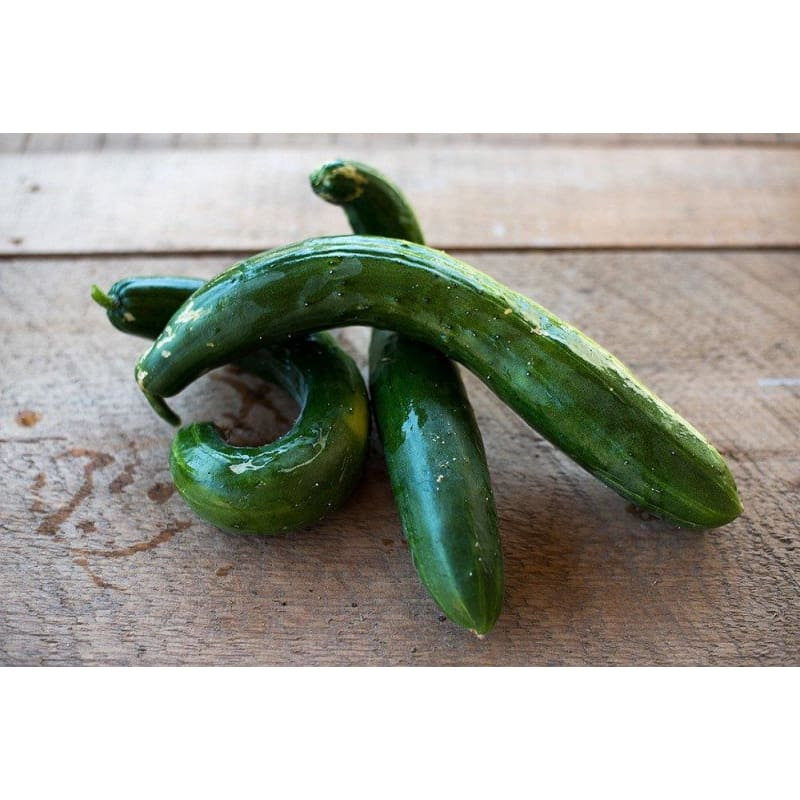
It’s a well-kept secret that cucumbers can burp. That’s why there are burpless varieties (wink!).
Nah, we’re just kidding!
If this is the first time you’ve ever heard about burpless cucumbers, we’re sure you scratched your head in confusion wondering if you heard that right.
With a zillion questions running through your mind, we’ve got all the answers right here! So sit back, relax, and read on as we give you the 101 on burpless cucumbers.
What are burpless cucumbers?

Burpless cucumbers are cucumbers that are bred to contain less cucurbitacin, a natural compound primarily found on its skin and stems that contributes to the fruit’s bitterness and induced burping.
Just as its name suggests, burpless cucumbers don’t make you burp as much as their regular counterparts.
Due to low levels of cucurbitacin, burpless cucumbers are a unique cucumber variety that is known to have fewer seeds, taste less bitter, and don’t make you burp as much, among other characteristics.
While there are still trace amounts of cucurbitacin in burpless cucumbers, there isn’t as much to trigger burping or indigestion.
It’s also worth mentioning that the cucurbitacin levels of regular cucumbers can rise when temperatures are higher outside. Hence, overripe cucumbers taste more bitter than ripe ones.
Why are they called burpless cucumbers?

Burpless cucumbers were given that name because they’re less likely to induce burping. This is attributed to their lower cucurbitacin levels, which are responsible for the gas that causes flatulence or burping.
As a result, some people prefer burpless cucumbers over regular cucumbers to avoid becoming gassy or bloated.
Meanwhile, others fancy less bitter-tasting cucumbers. Hence, the burpless variety is their go-to choice.
How are burpless cucumbers different from regular cucumbers?

There are several ways burpless cucumbers are different from regular cucumbers. Burpless cucumbers aren’t the best variety for pickling, they’re seedless, have tender and thinner skins, and taste less bitter.
1. Burpless cucumbers aren’t suitable for pickling

Most varieties of burpless cucumbers aren’t ideal for pickling because they produce an enzyme that causes them to become soft during fermentation. As a result, they lose their crisp, and you’re left with lifeless cukes.
Nevertheless, growing burpless cucumbers isn’t a complete waste. Pickling aside, they’re great for mixing up a green salad, blending in soups, making relishes, or even layering on sandwiches.
In fact, the possibilities are endless when you allow yourself to get creative in the kitchen.
Though if you’re adamant about pickling burpless cucumbers, just be sure to use cucumbers that are harvested about 50 to 70 days after sowing and are around 3 to 4 inches long.
2. Burpless cucumbers don’t have seeds

One of the reasons many love burpless cucumbers is that they’re practically seedless. Depending on the variety, burpless cucumbers don’t really have any seeds.
This is because burpless cucumbers are considered parthenocarpic. In layman’s terms, this simply means that even if its seeds ripen, they won’t be able to germinate.
Since burpless cucumbers have infertile seeds, you can’t plant these seeds and expect to be able to grow your own. You’ll need to go to the store to get a packet of seeds.
Nevertheless, a seedless cucumber for practically zero seeds doesn’t seem like too bad of a deal.
Among other perks, you don’t have to worry about removing the seeds when preparing them for dishes because they don’t have any. Thus, burpless cucumbers are great if you’re picky about seeds.
3. Burpless cucumbers have thinner skins

Fun fact: cucurbitacin is primarily located on the cucumber’s skin. Because that’s where the cucumber’s bitterness is concentrated, burpless cucumbers were made with less skin.
Thus, less skin = less cucurbitacin. Less cucurbitacin = less bitter tasting.
Since burpless cucumbers have thinner skins, they’re much easier to chew because the majority of the fruit is its soft core.
Aside from that, having thinner skin also makes it easier to prepare since you don’t have to bother peeling them. You can either chop them up or eat them as they are, which means less preparation time.
To boot, less skin = fewer digestion problems. This is because some people develop indigestion from cucurbitacin.
4. Burpless cucumbers are less bitter

Burpless cucumbers are well-loved for having thin skins which means they’re practically bitter-free! This is great news for those who can’t stand the bitterness of regular cucumbers.
Since burpless cucumbers have lower levels of cucurbitacin, they aren’t as bitter as other varieties.
Even then, they’ll begin to develop a bitter taste once they’re overripe. Hence, you need to harvest your cukes early before it’s too late.
Once they turn yellow, they’re already too bitter for most. When this happens, you can simply chuck them into the compost bin so that they aren’t a complete waste.
What do burpless cucumbers taste like?

Burpless cucumbers have a mildly sweet and refreshing flavor compared to their regular counterparts which have a rather bitter taste. However, they’re quite mild in comparison to other cucumber varieties.
This is because they don’t have thick skin and less cucurbitacin. As a result, burpless cucumbers are great for making salads and sandwiches.
However, drought and stress during your burpless cucumber’s growth period can increase its cucurbitacin levels. Thus, you’ll want to minimize the amount of stress that your burpless cucumbers receive.
What are the different varieties of burpless cucumbers?

If you’re thinking about growing burpless cucumbers in your garden, here are a couple of varieties to get you started!
1. Garden Sweet Burpless

| Common Name(s) | Garden Sweet Burpless |
| Unique Characteristics | • 10 to 12 inches long • Slender, cylindrical • Smooth but thin-skinned • Light to dark green shade • Faint stripes on the neck |
| Cucumber Size | 10 to 12 inches |
| Cucumber Taste | Sweet and bitter-free |
| Plant Type | Annual |
| Plant Spread | 24 to 36 inches |
| Plant Height | 6 to 8 inches |
| Watering Requirements | Moderate |
| Sunlight Exposure Requirements | Full sun |
| Climate Zone | Zones 9 to 10 |
The Garden Sweet Burpless is one of the most popular burpless varieties simply because it’s practically bitter-free. They taste sweet and are pretty refreshing, which makes them great for salads or a refreshing cucumber shake.
Garden Sweet Burpless plants grow to about 6 to 8 inches tall with a spread of about 24 to 36 inches. Because of their rather aggressive vining nature, it’s best to install trellises for structural support.
This also gives your cucumber plant a direction of where to latch onto and prevents it from growing too haphazardly. Once they its vines get tangled up in each other, it’ll be difficult to organize them.

Because they’re a warm-season crop, Garden Sweet Burpless varieties need to be planted in Zones 9 to 10. If you live in a colder area, make sure that temperatures don’t drop below 60F or 15C to prevent shock when transplanting.
When choosing where to plant your Garden Sweet Burpless cucumbers, select a location that receives full sun. Preferably a place that gets at least 6 to 8 hours of direct sunlight daily.

Sow your seeds about 6 inches apart. After your seeds have germinated (this takes anywhere from 3 to 10 days) and are about 4 inches tall, we suggest adding organic liquid fertilizer to boost their development.
Because they’re heavy feeders, it’s a great idea to give your Garden Sweet Burpless varieties regular applications of fertilizers, especially during their growing season. Alternatively, you can add a heap of compost or well-rotted manure into the soil.
It takes about 50 to 55 days for cucumbers to reach maturity. Once this happens, you can enjoy a fruitful harvest, typically during early summer or late

Since virtually all cucumber varieties are mostly made up of water, they need regular moisture to prevent them from drying out.
Having said that, they need to be watered about an inch deep weekly. In hotter weather, they could use a bit more water, depending on how their soil looks.
Then, you can water them deeply every three weeks just to ensure that the deeper layers of the soil are moist.

In the right growing conditions, you can expect your Garden Sweet Burpless cucumbers to grow to about 10 to 12 inches long.
They’re slender, cylindrical, smooth but thin-skinned cucumbers that have a light to dark green shade. They also have faint stripes on their neck that fade as it runs down the length of the fruit.
2. Burpless Bush No. 26

| Common Name(s) | • Burpless Bush No. 26 • Tasty Green 26 F1 • Burpless #26 |
| Unique Characteristics | • Usually perfectly straight • Smooth, thin skin • Deep green color |
| Cucumber Size | 4 to 12 inches |
| Cucumber Taste | Mild and refreshing |
| Plant Type | Annual |
| Plant Spread | 12 to 18 inches |
| Plant Height | 12 to 48 inches |
| Watering Requirements | High |
| Sunlight Exposure Requirements | Full sun |
| Climate Zone | Zones 4 to 12 |
Did you know that the Burpless Bush No. 26 is actually a hybrid of the Straight Eight varieties in the 1940s? Despite not having been in existence for that long, they’re a fan favorite.
Burpless Bush No. 26 cucumbers are usually perfectly straight and have smooth, thin skin and a deep green color.
They’re also mildly flavored, which makes them a great all-around cucumber. They go well sliced on burgers, tossed in a salad, or even pickled.
Aside from that, they’re well-liked for being nearly seedless. Thus, you can expect little to no digestive issues when consuming these.

Depending on its growing conditions, Burpless Bush No. 26 cucumbers can reach lengths of up to 12 inches. If you’ll use them for picking, anywhere from 4 to 8 inches will be the perfect size.
Because of their length, it’s best to grow them on stakes or trellises, or else their fruits will curve.
Aside from that, the Burpless Bush No. 26 is known to have long vines. Hence, providing structural support is necessary to prevent a chaotic mess of vines in your garden.

When growing Burpless Bush No. 26, it takes about 6 to 10 days for germination to take place. Just make certain that the frost has ended to ensure that germination is successful.
If it’s still pretty cold where you live, you can start your seeds indoors. After around 2 to 3 weeks and when the temperature rises, you can transplant your seedlings outdoors.
Then, you can expect a harvest after around 50 to 60 days. If you’re aiming to make the most out of your crop, we recommend regular picking to push the vines to grow more fruit.

While being relatively low maintenance, the Burpless Bush No. 26 requires full sun and a lot of water to support its growth.
When choosing a spot to grow your cucumbers, select a location that receives about 6 to 8 hours of sunlight.
Give your plant about 1 inch of water weekly. During the summertime, you may need to increase the amount of water you give your cucumber plants depending on the state of the plant itself and the soil.
It’s an important factor to water consistently to avoid stressing out your plant which can result in poorly shaped cucumbers.
3. Summer Dance

| Common Name(s) | • Summer Dance • Summer Dance Hybrid Cucumber • Cucumber Summer Dance |
| Unique Characteristics | • Glossy, dark green skin • White spines • Almost entirely uniform appearance and size |
| Cucumber Size | 8 to 12 inches |
| Cucumber Taste | Mild and lightly sweet |
| Plant Type | Annual |
| Plant Spread | 36 to 48 inches |
| Plant Height | 12 to 48 inches |
| Watering Requirements | High |
| Sunlight Exposure Requirements | Full sun |
| Climate Zone | Zones 4 to 12 |
The Summer Dance is a hybrid Japanese-type cucumber that’s well-loved for its unbelievably thin skin. In fact, some don’t even bother peeling it.
Its fruits have a mild yet sweet and refreshing taste, which makes them great for nearly any recipe.
They grow to be about 8 to 12 inches depending on their growing environment. Though in most cases they’re entirely uniform in appearance and size.

They have dark green, glossy skin with white spines scattered all over them. Meanwhile, some have a light green-yellowing tip.
The Summer Dance cucumbers are also usually slender and long. However, there are instances wherein its fruits are curved, which is most likely the result of growing on the ground.
Hence, it’s highly recommended to grow these Japanese cukes vertically on trellises or stakes to allow them to develop properly.
Having mentioned that, they have aggressive vining behavior and can reach a spread of 36 to 48 inches. As a result, its vines can easily get tangled up when not maintained properly.
So as early as the transplanting stage, plant your Summer Dance plants about 4 to 6 feet apart. This will ensure that each plant has enough space and they aren’t competing for resources.

Compared to other burpless cucumber varieties, the Summer Dance takes a bit longer to reach maturity at about 70 days. Even then, it’s highly recommended to pick at it every once in a while to encourage vine growth and fruit yields.
Since they’re pretty heavy feeders, you’ll want to add complete soluble fertilizer as early as possible; preferably during their growing season for maximum benefits.
Aside from that, adding well-rotted manure and high-quality mulch mixes are great sources of added nutrients, too.

Just like other cucumber varieties, the Summer Dance needs to be planted in an area that receives full sun if you want to harvest the most yields.
They also have high watering requirements, so be sure to keep the soil moist at all times. Though be careful not to overdo it or else you could risk your Summer Dance developing diseases.
On the bright side, the Summer Dance variety has a reputation for having good disease resistance, so there isn’t much to worry about.
4. Burpless Beauty

| Common Name(s) | Burpless Beauty |
| Unique Characteristics | • Dark green, smooth skin • Faint stripes on their neck • Small, white cavity with small seeds |
| Cucumber Size | 8 to 10 inches long |
| Cucumber Taste | Sweet and refreshing |
| Plant Type | Annual |
| Plant Spread | 3 to 4 feet |
| Plant Height | 6 to 8 inches |
| Watering Requirements | High |
| Sunlight Exposure Requirements | Full sun |
| Climate Zone | Zones 4 to 12 |
The Burpless Beauty cucumber is another popular variety because of its thin skin and crispiness. As a result, this beauty is a popular choice for those who’d like to preserve these cukes for longer.
Apart from that, it has a small seed cavity. Hence, there are practically no seeds, so you don’t have to worry about encountering any digestive issues.
Burpless Beauty cukes are also sweet, refreshing, and bitter-free. This makes them a tasty treat on their own or used in a variety of dishes.

Another unique trait of the Burpless Beauty is that they don’t need bees to pollinate, unlike most cucumber varieties. Thus, you don’t need to wait until you’ve got your garden started to plant these.
Once temperatures rise and the danger of frost has gone, you can sow your Burpless Beauty seeds about 3 inches apart.
After covering each seed with half an inch of soil, water generously to keep the soil moist and kickstart their germination.
Seedlings will begin to sprout after a week or two. From there, you can choose the best ones of the batch to transplant outdoors.

It’s worth highlighting that their vines are quite sensitive, so it’s best to avoid moving them once transplanted. Thus, be sure to choose a location that receives a lot of full sun, about 6 hours daily.
In about 50 days after planting, you can start harvesting your 8 to 10-inch long cukes. Though in warmer weather, they have a tendency to yield quickly, so you could be harvesting daily.
To avoid damaging the fruits, we recommend using a sharp knife or pair of scissors to cut it from the vine rather than yanking it off.
5. Sweet Success

| Common Name(s) | • Sweet Success • Sweet Success Hybrid Cucumber |
| Unique Characteristics | • Tender with a small cavity • Smooth and thin-skinned • Dark green and long |
| Cucumber Size | 12 to 14 inches |
| Cucumber Taste | Mildly sweet |
| Plant Type | Annual |
| Plant Spread | 4 to 5 feet |
| Plant Height | 5 to 8 inches |
| Watering Requirements | Moderate |
| Sunlight Exposure Requirements | Full sun |
| Climate Zone |
Just like its name suggests, the Sweet Success burpless variety is a winner! This high-performing cuke actually garnered an AAS award in 1983 which is only bestowed upon the best of the best.
The Sweet Success plant grows fruits that are about 12 to 14 inches long with thin, smooth skin, which means that they don’t have a bitter taste. For some, this also means that they can skip the peeling and get straight to chomping.
Aside from that, it has a rather small cavity, making it practically seedless. This is because they’re considered a parthenocarpic hybrid, which means that they don’t need a pollinator to yield fruits.
However, Sweet Success has a tendency to grow undeveloped seeds when they’re planted alongside other cucumber varieties. So if you want completely seedless Sweet Success cukes, keep them away from other cucumber plants.

For some gardeners, this is one of the best things about growing Sweet Success varieties. Once growing conditions are ideal and the risk of frost has gone, they can start planting seeds without waiting for the rest of the garden to come alive.
Once temperatures have risen, you can directly sow their seeds into the soil. Alternatively, you can start them indoors until their first leave appears.
Afterward, you can transplant them outdoors in an area that has moist yet well-draining soil and receives full sun.

Since they’re known to grow like crazy, it’s recommended to grow plants about 24 inches apart. Meanwhile, rows should have a 48-inch gap in between.
This will ensure that there’s enough space for their dense foliage to grow without cutting off ventilation.
Aside from that, you’ll need a lot of space to put up trellises and stakes, too. Otherwise, you’ll risk your cukes curving when they’re growing on the ground.
On the bright side, Sweet Success is known to yield a lot more fruits than its other burpless counterparts. Thus, expect harvesting cukes a lot more frequently, so we suggest figuring out what you want to do with all of them early on.
6. Muncher

| Common Name(s) | • Muncher • Muncher Burpless |
| Unique Characteristics | Medium green and smooth-skinned |
| Cucumber Size | 8 to 10 inches |
| Cucumber Taste | • Sweet • Crunchy • Low acid |
| Plant Type | Annual |
| Plant Spread | 1 to 2 feet |
| Plant Height | 12 to 48 inches |
| Watering Requirements | High |
| Sunlight Exposure Requirements | Full sun |
| Climate Zone | Zones 4 to 12 |
Just like it’s called, the Muncher is a favorite to munch on because it’s sweet, crisp, and refreshing. It has thin skin that doesn’t have a bitter taste, which means that you can get away with eating it straight from the garden.
Compared to other burpless varieties, the Muncher is wider at about 2 to 3 inches. It’s also quite long, capable of growing to about 10 inches.
Its fruits also have low acidity levels, which makes them a great choice for canning or pickling.

As a warm-weather crop, the Muncher is typically started indoors to prevent frost damage. If not, you can simply wait until temperatures are above 60F or 15C to start them outdoors.
It’ll only take about 3 to 10 days before the seeds begin to germinate. Once they’re started establishing true leaves, you can then transplant them.
It’s worth highlighting that Munchers along with other cucumber varieties have a rather shallow root system. Hence, it’s best to plant them about 5 inches deep into the soil and add a layer of mulch for added protection.
This will also provide additional nutrients to the soil. While you’re at it, you can also give regular applications of fertilizer, especially during its peak growth period.

Munchers need about 6 hours of direct sunlight each day along with a ton of water to keep the soil moist. Depending on what the weather’s like, you can add or lessen the amount of water you give.
They’ll also need structural support to latch onto given their vigorous vining nature. If you have a bush variety, they do well in raised beds or pots.
After about 60 days since they’ve been sown, your Munchers will be ready for harvesting. It’s recommended that you wait until they reach about 7 to 9 inches long as this is when they taste the sweetest.
7. Burpless Tasty Green

| Common Name(s) | Burpless Tasty Green |
| Unique Characteristics | • Medium to dark green-colored skin • White spines scattered around |
| Cucumber Size | 6 to 8 inches |
| Cucumber Taste | Sweet and crisp |
| Plant Type | Annual |
| Plant Spread | 15 to 18 inches |
| Plant Height | 7 to 9 inches |
| Watering Requirements | Moderate |
| Sunlight Exposure Requirements | Full sun |
| Climate Zone |
The Burpless Tasty Green is one of the most popular of the burpless varieties because of how easy it is to grow. A Japanese cucumber, it can grow a generous yield in the right growing conditions, whether indoors or outdoors.
Because of its productive behavior, providing it with structural support isn’t an option due to how heavy it can get. Hence, its vines will need all the help that it can get.
Once sown, it only takes about a week for its seeds to germinate. From there, they can be moved to a location that receives partial shade such as next to a well-lit window to avoid getting scorched.

After its true leaves have grown in, the seedlings can then be transplanted into their individual pots or in-ground. For the latter, ensure there’s enough space between each seedling, about 18 inches apart.
You’ll need to water your cucumber plants regularly and consistently so that the soil remains moist. However, avoid pooling water as this could affect the quality of your cukes and the overall health of your plant.
Other than that, you’ll need to be wary of any slugs and pests that could already be munching on your plant.

As heavy feeders, don’t skip adding extra sources of nutrients for your cucumber plants, especially at their peak growing period. You can add soluble fertilizer, mulch, or even well-rotted manure to boost production.
To ensure that all of the plant’s energy goes into its yields, punch off the side shoots. After around 55 to 65 days, your plant has reached maturity and harvesting can begin.
The Burpless Tasty Green’s fruits are usually quite slender and can grow to around 6 to 8 inches long. They have medium to dark green-colored skin along with a couple of white spines scattered around.
FAQs
Unfortunately, all cucumber varieties aren’t frost tolerant. As warm-season crops, it’s best to wait until the end of frost to plant burpless cucumbers for an optimal harvest.
When burpless cucumbers aren’t harvested on time, they become overripe. Its color changes from a deep green to yellow.
Aside from that, its taste changes, too. What was once a bitter-free cucumber has now developed an incredibly bitter taste.
The best way to harvest burpless cucumbers is to use a sharp knife or scissors to prevent injuring the plant. A dull tool won’t be able to cut easily and will force you to apply more pressure, which will damage the plant.
You can grow your burpless cucumbers horizontally, but it’s recommended to grow them vertically to increase air circulation, prevent diseases, and make harvesting its fruits easier.
When dense foliage is on the ground, it tends to get wet. The constant moisture and limited space will decrease ventilation, boosting the likelihood of your plant developing diseases and getting attacked by pests.




